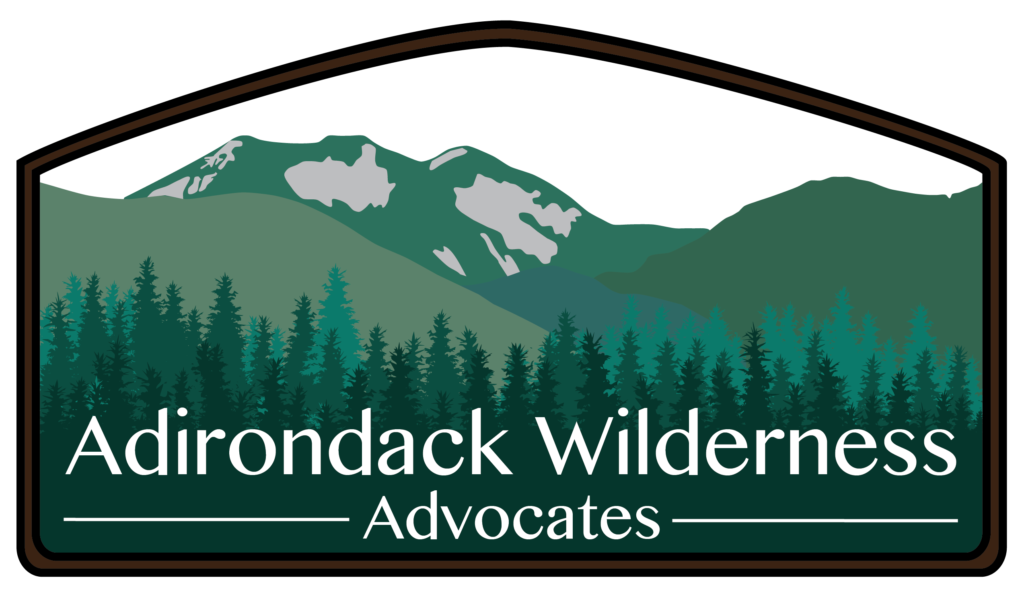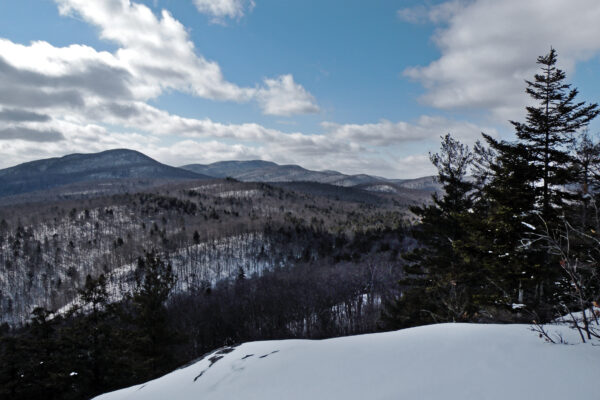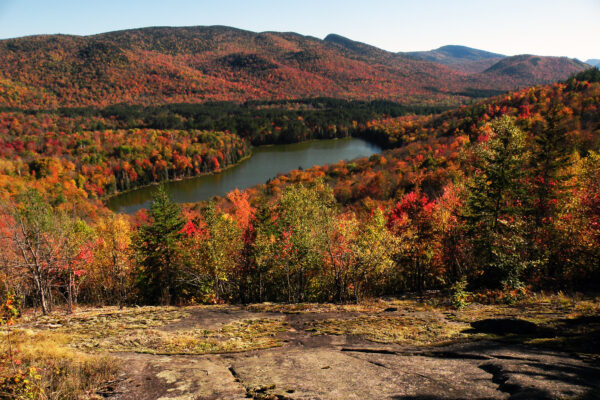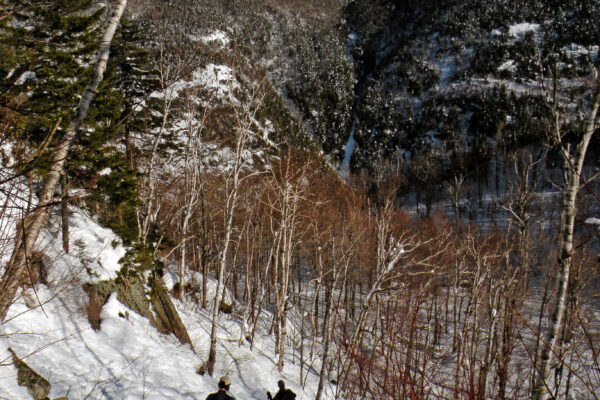Part 1 of 4
Editor’s Note: The following is a previously-unpublished essay written in 2003 by the late Barbara McMartin (1931-2005). In her original vision, this was to be published as a pamphlet with the working title “A Short History of Adirondack Trail Building,” part historical survey and part advocacy. No such pamphlet was ever published, and her 7300-word draft has been aging in my email folders ever since. McMartin was an outspoken advocate for trails, and her response to crowded and “overused” trails was that more trails were needed to satisfy public demand. This “Short History” attempts to defend that position by arguing New York State has never developed a master plan for hiking trails, and that the hiking trail network as it existed during her lifetime happened more or less by historical accident. Although 18 years have passed since she drafted these words, and much trail building has indeed occurred that would’ve pleased McMartin, it still seems we are debating many of the same topics that occupied much of her career. Thus there is a timeliness in posthumously publishing one of her final essays now. –Bill Ingersoll
Part of a series on the history of Adirondack trails:
Part 1: A Short History of Adirondack Trail Building
Part 2: Trails in the Mountain Pleasure Grounds
Part 3: An Advocate for Trails
Part 4: So Much Work to Be Done
Hindsight is wonderful! With what we know about the Adirondacks today and what we know about building trails, we could devise the most wonderful trail network, one that would protect the fragile slopes of the High Peaks, take hikers to mountaintops all around the Park, and ameliorate problems of overuse and under-use. At the same time we could create the most spectacular network of trails of different levels in the eastern United States for the entire range of people who enjoy the out-of-doors, from the disabled to families with youngsters, from those who have never visited the Adirondack before to those who have already enjoyed its challenges, and from the fleet of foot to the elderly. That the current trail system does not meet these ideals stems in part from the origins of Adirondack trails and also explains why there are no trails to some of my favorite destinations.
A few old routes, such as the trail through Indian Pass, probably did originate as Indian travel routes, but since early settlers undoubtedly adopted these valley routes, there is no sure way to determine which routes were Indian tracks.
The vast majority of trails in the Adirondacks, notably those in the southern part of the Park, especially snowmobile trails, and some of our best relatively level deep-woods walks, had two principal sources. Some began as primitive roads between settlements: The trail from Oregon to Baldwin Springs in Warren County was part of a road that continued on to Stony Creek and was used by settlers with carts pulled by oxen. The current snowmobile trail between Willis Lake and Wilcox Lake was part of a road from Harrisburg west to Wells. The Kunjamuk trail to Kings Flow, in Hamilton County was part of the original trail north from Speculator to Indian Lake. The Brown’s Tract Road in the Ha-de-ron-dah Wilderness was part of the original road to Old Forge from the west. The Jack Rabbit Ski Trail in the valley north of Pitchoff was once the route between Keene and Lake Placid.

Many more were originally roads to logging camps— trails in Hammond Pond Wild Forest and Ha-de-ron-dah Wilderness began as early logging roads. Trails in the northern part of the Five Ponds Wilderness and most of the roads and trails in the Moose River Plains began as roads for logging in the early part of the nineteenth century. The northern part of the trail south from the Moose River Plains Road toward Brooktrout Lake was a logging road built by Gould Paper Company as were the trails west of Indian River leading to Horn and Stink lakes. Part of the Northville-Placid Trail north of Big West and the Cedar Lakes is along a logging road.
Roads were built from tanneries to hemlock forests and some of these are modern trails, though most, like many tannery sites, have faded back to wilderness and if visible at all are only unmarked footpaths. Among the still-visible routes are trails northeast of Brant Lake and east of Schroon Lake in the Pharaoh Lake Wilderness. Trails west of Schroon Lake such as the trail to Big Pond had their origin as tote roads for bark.
Beginning in the early part of the nineteenth century, these routes, which enabled settlers to gain access to the region’s natural resources and build settlements near sources of waterpower, gradually reached deep into the wilderness. As the merchantable trees – primarily spruce – were harvested, as tanneries moved away and the need for hemlock bark declined, and as iron mines elsewhere proved more valuable, the settlements began to shrink. Many of these roads have just disappeared – the old roads to North Branch Reservoir, the Notch Road, and the Groff Creek Road are just three of many vanished old routes in the Silver Lake Wilderness.

A few trails follow parts of even older state roads. The first state road to be authorized by the legislature was the Chester to Canton Road (1807). It was followed by the Northwest Bay to Hopkinton Road (1810). The Albany Road was authorized in 1812; it followed an old Indian Trail and traversed the Park from the southeast to the northwest, reaching Russell and ultimately the St. Lawrence near Ogdensburg. These routes, often erroneously called military roads, were designed to open up the wilderness and provide access across the mountains to the fertile lowlands of the St. Lawrence Valley. The Cedar Point Road (1828) led from Lake Champlain to the iron works at Tahawus. It was superseded by the Carthage Road (1841) which stretched from Crown Point village to Carthage on the Black River.
These early roads were little more than tracks cut through the forest, though corduroy (logs placed crosswise in the road) filled extensive wet areas on these roads, especially along the Carthage Road. Parts of these early roads are now modern highways, other parts have disappeared completely. The faded segment of the Albany Road between Sled Harbor and Cedar Lakes was reopened by the hermit, French Louie, in 1873, and it was designated the French Louie Trail by DEC in 1996.
A few trails follow old railroad grades. Part of the trail from McKeever to Woodhull Mountain follows the old McKeever Railroad grade. Snowmobile trails use the Jerseyfield railroad north of Salisbury. Snowmobile trails have been designated along abandoned parts of the Adirondack Division of the New York Central Railroad and the railroad grades north of Tupper Lake.

Railroad beds have also become hiking trails. Sections of the Raquette Lake Railway are now marked for hiking. A raised railroad grade leads north from Saranac Lake through Bloomingdale Bog. The trail south from Inlet that curves west to parallel the Oswegatchie River follows the bed of the Rich Lumber Company’s logging railroad. The canoe carry between the Marion River and Utowana Lake is along the Marion River Railroad grade.
Some trails follow roads to mines such as the paint mine near Bennett Lake northwest of Hope Falls (the mine was a pit that yielded iron oxides which mixed with oils made the red paint so familiar on barns and schools). The now-faded route south along Kings Flow was once part of the road to a garnet mine on Humphrey Mountain. A few trails follow roads that led to sugarbushes—the Girard Sugarbush trail southeast of Griffin is now a part of a snowmobile trail.
Fishermen and hunters kept many of the original roads open and pushed many more on to their favorite lakes and ponds. French Louie branched out from the Cedar Lakes to cut trails south to the West Canadas. Lodges or camps that catered to sportsmen became the centers of networks of paths. The Van Dusen farm at Old Farm Clearing near Thirteenth Lake was one. From it sportsmen’s trails were kept open to Hour, Puffer, Twin and Peaked Mountain ponds. A guide, Frank Warren, kept the trail to Siamese Ponds open so sportsmen could visit his camp there. The John Seavers, original proprietors of the camp at Whitehouse, and their successors maintained paths along the West Branch of the Sacandaga. Kenwell’s camp for sportsmen in the Moose River Plains was the locus of paths that reached out to numerous streams and ponds.

Many of these trails and paths that served mostly sportsmen predate the establishment of the Adirondack Park. Beginning in 1872, Edwin R. Wallace published yearly updates of his Adirondack guides that told how to reach the Adirondack hotels by water routes and rudimentary roads. The descriptions included routes used by sportsmen and those that followed the guides helped make the faint paths into well-used trails.
In areas where there were no logging roads, most modern trails follow sportsmen’s routes. This is true in the southern two-thirds of the Five Ponds and the Pigeon Lake Wilderness areas. These include the trail to Constable Pond and others near Big Moose. The trail from Big West to Brooktrout Lake is a sportsmen’s route, probably first used by French Louie.
The complex of trails on the east side of Lake George north from Shelving Rock was a network of carriage trails on the Knapp Estate. Old roads on the west end of Lake Lila and the trail up Mount Frederica were private trails on the former estate of Dr. William Seward Webb. Trails to Streeter Lake and south to the Oswegatchie were roads on the Schuler Estate, famous for its potatoes. A few private trails are open to the public. The trail up Rattlesnake at Highlands is the best in this category.
Trails in the eastern High Peaks were actually built for mountain climbing and many of them also were built before 1892. Guides such as John Cheney, Orson Phelps, Orlando Beede, and Bill Nye are credited with cutting the trails to some of the tallest of these mountains. Nye cut the trail from Lake Placid to Whiteface in 1865 and in 1878 cut the trail designed by Henry VanHoevenbergh to Marcy from the north. Orson Phelps blazed a trail to Marcy in 1861 and with his son cut a trail to Giant in 1866. Phelps opened the Marcy-to-Skylight trail in 1875. The trail from Keene Valley up the north slopes of Dix had its origin in a route pioneered by Orlando Beede.
Verplanck Colvin’s men cut trails to many High Peaks from 1872 on as part of the Adirondack Survey. Some of these survive as trails, among them the trail up Algonquin from Lake Colden. The present route up Santanoni dates from Colvin’s survey work.
In later years, organizations have cut trails to some of these tall mountains. The Tahawus Club cut a trail to Santanoni along the earlier Colvin route. The Camp and Trail Club, founded by Henry Van Hoevenbergh, cut the trail from Avalanche Pass up the north slopes of Mount Colden, though this trail no longer survives. Van Hoevenbergh oversaw the 1881 cutting of the trail up Algonquin from his Lodge at Heart Lake. Hikers pioneered many other mountain routes, as detailed in Russell Carson’s Peaks and People.

The Adirondack Mountain Reserve (AMR) was organized to protect the trace containing the Ausable Lakes as well as to provide cottage sites and recreational opportunities for its members. Trails from the Ausable Lakes were built by the Adirondack Trail Improvement Society (ATIS), founded in 1897 as an arm of AMR. Members of ATIS completed the Range Trail in 1911.
Hotels and resorts in other regions began to capitalize on the surrounding forests. A hotel at Big Moose Lake encouraged guests to enjoy that region’s trails before the turn of the century. The network, through mostly virgin forest tracts, is virtually unchanged today.



